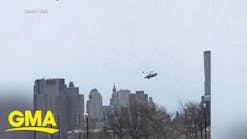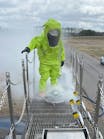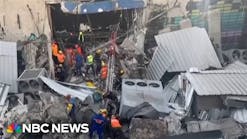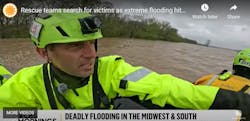On Friday, June 19, 2009, a Canadian National freight train derailed and caught fire in Cherry Valley, IL. The train consisted of two engines, one car carrying scrap metal, one empty liquid tank car, 36 empty cars, one car carrying gravel and 74 tank cars, each containing 28,800 gallons of ethanol. Before the incident was concluded, firefighters and equipment from 33 fire departments in northern Illinois and southern Wisconsin responded to the scene or provided coverage at Cherry Valley fire stations.
A weather front moved through northern Illinois on Friday evening, dumping more than four inches of rain on Cherry Valley and Rockford and causing widespread flash flooding. More than three inches of rain fell between 7 and 8 P.M. Cherry Valley fire companies consisting of two engines, one ladder, one heavy rescue, one technical rescue and boat, two advanced life support (ALS) ambulances with 22 firefighters and Battalion Chief Bill LeFevre had been busy rescuing motorists from vehicles that were caught in the flash flooding of roadways. Just before the derailment, calls to the Winnebago County 911 center reported that the railroad tracks at 3400 South Mulford Road were washed out.
The Canadian National train enroute from Tara, IA, to Chicago, IL, was 6,940 feet long containing 114 rail cars. Nineteen cars of ethanol derailed with 15 cars involved in fire with 323,963 gallons burning.
Initial Response
At 8:38 P.M., while returning from the water rescues, units from the Cherry Valley Fire Protection District were dispatched to Mulford Road and Sandy Hollow Road for a reported train derailment with explosions. Cherry Valley Fire Chief Craig Wilt and Deputy Chief Doug Hayes also responded on the initial dispatch. Due to numerous 911 calls reporting the incident and giving different locations, as it was on the border of Cherry Valley and Rockford, the city of Rockford also dispatched two engines, one ladder, two quints, one hazmat unit, two aircraft rescue and firefighting (ARFF) trucks, two advanced life support (ALS) ambulances and two district chiefs.
Upon arrival, Wilt advised incoming units of a train derailment involving multiple tank cars of unknown product with a major fire. Many pressure-relief valves could be heard operating. The derailment occurred at a crossing with Mulford Road, a heavily traveled north-south road, and was blocking the roadway. The next-closest highway crossings were three miles to the east and west.
Wilt assumed command and established the command post at the intersection of Mulford Road and Abbington on the north side of derailment. The first ambulances, Cherry Valley 1C13 on the north side and Cherry Valley 1C56 with Rockford 1C28 on the south side, arrived just ahead of Wilt and were advised immediately that they were too close and to back out to the command post on the north and Sandy Hollow and Mulford Road to the south. Both locations were a quarter-mile from the burning tank cars. Both Cherry Valley ambulances and one Rockford ambulance reported they had burn victims, two with critical burns, and one fatality on the south side, and three to four victims on the north side with minor to moderate burns. Command advised all ambulances they were to load the victims and pull back to a safe area and treat the victims there. LeFevre was assigned as the chief's aide.
Units arriving on the north side included Cherry Valley Engine 503, Ladder 551, Rescue 541 and Ambulance 1C13 along with Rockford Quint 5, a hazmat unit, two ARFF units from Rockford Airport and a Mutual Aid Box Alarm System (MABAS) Division 8 decontamination truck. Command advised that the first-arriving unit on the south was to take the South Sector. Units arriving on the south side included Cherry Valley Engine 502, Technical Rescue 543, Tenders 571 and 572, Ambulance IC56 and Brush 562. Rockford Engines 2 and 10, Ladder 2, Quint 7, District Chiefs 1 and 2 (Lynn Washburn Livingston and Steven Preiss), and two ambulances.
Preiss assumed South Sector command until the arrival of Hayes at 9:30 P.M., at which time he assumed South Sector command with Battalion Chief Allen Geeser as his aide. Bystanders were initially a problem, with many trying to get close enough to take pictures with cell phones. Fire units pulling back used apparatus loudspeakers to order people to leave the area, but this action failed and the police were needed to make them leave.
Mutual Aid
Command requested mutual aid at 8:58 P.M., using MABAS and requested Cherry Valley MABAS Box 11 to the second-alarm level. This response included six engines, two ladders, two heavy rescues, four chiefs and one ambulance from area departments. Staging areas and rapid intervention teams were established on both sides of the derailment. The rapid intervention teams were Cherry Valley Rescue 541 on the north side and Byron Rescue 441 on the south side.
On the north side of the derailment, both the east and west sides of Mulford Road are heavy populated residential areas consisting of approximately 700 homes with 1,500 to 1,800 residents. Many homes were within 150 yards of the burning tank cars. Due to the close proximity of these homes, command ordered an evacuation area of a half-mile radius. On the south side, east of the road was vacant farmland and on the west side were unoccupied commercial buildings. Police began evacuating these areas at 9:10 P.M.
Binoculars were used to try to identify the product or products and the types of tank cars involved and whether they were pressurized. Due to the massive amount of fire, wreckage and darkness, it remained undetermined. The South Sector advised they had a parking lot where they could set up a ladder pipe operation to put water on a line of uninvolved tank cars still on the track to try and keep the fire from spreading to them. Command advised that once it was set up, it would have to be left unmanned. Rockford Ladder 2 was set up for aerial master stream operations and supplied by a 300-foot, five-inch line that was pumped by Rockford Engine 2 under Preiss' direction.
More Units Called
At 10 P.M., a large portion of the residential area still needed to be evacuated. Command requested MABAS Box 11 be upgraded to a sixth alarm to help police go door to door to evacuate residents. This consisted of an additional 11 engines, two ladders, two heavy rescues and eight chiefs from departments in northern Illinois and southern Wisconsin. Staging for these units was designated at the Cherry Vale Mall, a regional shopping center, because of its large parking lot and lighting. The mall was about three miles from the incident.
At 10:20 P.M., the train crew was located and brought to the command post. The engine and forward portion of the train had come to a stop two miles east of the derailment and the crew was walking back toward the scene and setting brakes on the railcars when they were located. The train manifest showed that all the tank cars were each carrying about 28,800 gallons of ethanol. Command decided to leave the evacuation zone at a half-mile, which is the U.S. Department of Transportation (DOT) Emergency Response Guide (ERG) recommended distance for a rail tank car involved in fire.
Command met with hazmat personnel from Cherry Valley Fire, Rockford Fire and the Canadian National Railroad to plan the best course of action. Fire department units had 400 gallons of alcohol-resistant aqueous film-forming foam (AR-AFFF) on scene and the railroad had 900 gallons enroute. It appeared the fire could involve up to 15 tank cars containing up to 30,000 gallons of ethanol each mixed with 3% gasoline. It was determined that there was not enough foam available to be brought to the scene nor could firefighters get close enough to the fire safely to apply it. Many pressure-relief valves were operating at a high pitch. It was unknown whether any valves were damaged and not operating or whether tank cars were overturned with valves buried. Several cars had already failed prior to arrival. Command decided to let the fires burn down.
At midnight, the Illinois Emergency Management Agency Unified Command vehicle arrived on scene and Wilt moved the command post into this vehicle with representatives of the police and railroad. Hayes was moved to the command post as the logistics officer, and Geeser and Win-Bur-Sew Fire Chief Rob Martin were brought in and assigned to write an Incident Action Plan (IAP) for the next day and prepare for a multi-day event. LeFevre remained at the initial command post to assist North Park Fire Department Chief Steve Pearson, who was assigned as the operations chief.
At 2:30 A.M. on June 20, command was advised that all evacuations were complete. At 3 A.M., LeFevre was sent home for rest as he would be the incident commander during the overnight hours of June 20. At 3:30 A.M., command began releasing mutual aid companies from the mall staging area to return to their departments. Command decided to leave two alarms of units in the north and south staging areas in case of any unforeseen event.
Decision Made To Extinguish Fire
By 10 A.M. on Saturday, the fire on the west side began to burn down to a level where command and railroad personnel felt it could be extinguished safely. Cherry Valley Engine 503 supplied two unmanned monitors that were set up on the north side, each flowing 750 gpm. Engine 503 was on a hydrant 300 feet north of the incident. On the south side, Dixon Rural Fire Department Engine 3 supplied two unmanned monitors. This engine was fed by a hydrant on the south side. The fire was extinguished and water flow was maintained for one hour for cooling of the tank cars. At noon, it was determined that it would be safe for crews on the south side to remove the body of the adult female killed while trying to flee her vehicle. This operation was completed at 12:10 P.M. by the Winnebago County Coroner's Office with Harlem Roscoe Fire Chief Donald Shoevlin. The National Transportation Safety Board (NTSB) arrived at 1 P.M.
During the afternoon, it was discovered that the truck and wheels from one tank car penetrated the dirt next to the road to a depth of 10 feet, striking and damaging the outer casing of a 16-inch natural gas distribution line operating at 288 psi. The inner pipe was not damaged. Had the train been going faster, it is believed, the inner pipe would have been damaged, causing a high-pressure natural gas-fed fire in the middle of the derailment and impinging on the tank cars.
The tank cars on the east side continued to burn actively with relief valves operating until 3 P.M., when the fire started to burn down. Command had two monitors placed on the north side and two monitors on the south each flowing 750 gpm. Water flow was maintained for two hours to cool the tank cars. Command advised that all fires were extinguished at 5 P.M. on Saturday, 20½ hours after the initial dispatch. Once the fires were extinguished, the NTSB began its investigation.
All mutual aid companies were released at 5 P.M., and all fill-in companies were released at 6 P.M. on Saturday. At 5:30 P.M., evacuees were allowed to return to their homes. At 6 P.M., command was transferred to LeFevre for the overnight hours. As the NTSB progressed with the investigation, it let the railroad begin removing the wreckage. Private-contract recovery and firefighting crews began removing the tankers by foaming the inside of each tanker and then lifting them by special bulldozers and carrying them to an open area between the two sets of tracks. During this time, Cherry Valley firefighters provided fire protection to the recovery crews and the crews digging up the natural gas line that was struck.
At 9 A.M. on Sunday, Wilt assumed command of operations until 4 P.M., when it was determined that the fire department was no longer needed and Mulford Road command was terminated. During this operational period, Cherry Valley firefighters continued to protect recovery crews as wreckage was removed and cut up. At one point, railroad personnel requested confined-space firefighters to standby as they needed to enter one tanker.
Conclusion
This was the largest incident in the history of the Cherry Valley Fire Protection District and as bad as it was, it could have been much worse. The train was traveling 34 mph in a 50-mph zone. The train had experienced wheel slippage coming out of Rockford going up an incline because of wet tracks, and the engineer backed off on the throttle. At the time of the derailment, the train was just starting to pick up speed again. Had it been going 50 mph, it is believed, there probably would have been no survivors from the vehicles at the rail crossing. One person, a 41-year-old woman, died at the scene from burns. Her 40-year-old husband and 17-year-old daughter, who was five months pregnant, were both critically burned. The fetus did not survive. They were in a minivan on the south side, the first vehicle in line at the crossing waiting for the train to pass. Five people who were in vehicles on the north side of the crossing received injuries from minor to moderate. Damage was estimated at more than $1.5 million. Two firefighters suffered minor injuries.
The American Red Cross and the Salvation Army were called to the scene to provide food and water to firefighters. The police department activated its mutual aid system and had police officers from over 20 agencies assisting with traffic and crowd control.
JAY K. BRADISH/IFPA, Firehouse® news editor, is a former captain in the Bradford Township, PA, Fire Department. He has been a volunteer firefighter and fire photographer for more than 25 years.
ON THE JOB: ILLINOIS
CHERRY VALLEY FIRE PROTECTION DISTRICT
Chief: Craig Wilt
Personnel: One career chief, one career deputy chief, one career inspector, 12 career firefighters, two paid-on-call battalion chiefs, six paid-on-call lieutenants, 35 paid-on-call firefighters
Number of Stations: 2
Apparatus: Two pumpers, one ladder tower, one heavy rescue, one technical rescue squad, two tenders, two brush units, three command vehicles, two ALS ambulances, one reserve pumper, one reserve ambulance
Population: 30,000
Area: 25 square miles
LESSONS LEARNED
• Problems — At such a large incident, someone is needed at the command post to make written notes of important radio, voice and phone communications. Multiple radio channels, in-person orders and cell phone calls were used between sectors. While playing back radio tapes after the incident for report making, it was found that because the incident was some distance from dispatch, many portable-to-portable radio transmissions were not recorded, and not all channels that were used were recorded channels. Someone on scene is also needed as a timekeeper at large incidents to remind the incident commander at benchmark times. It was easy to lose track of time.
• Successes — With a large-scale fire that could be seen from miles away, life safety was an immediate issue as numerous civilians were drawn toward the incident. No civilians were killed or injured after the initial accident and a large-scale evacuation was safely carried out of all persons who were in immediate danger.
Cherry Valley firefighters are all trained to the hazardous materials awareness level and numerous firefighters are trained to operations and technician A and B levels. The U.S. Department of Transportation (DOT) Emergency Response Guidebook (ERG) was used in the initial stages of the incident until the arrival of Cherry Valley Fire and Rockford Fire hazmat teams. While not specifically prepared for multi-day incident with 15 tank cars burning, responders were prepared for a major fire event. In this instance, the Mutual Aid Box Alarm System (MABAS) box card for a commercial fire in a hydrant area was used to get the additional resources needed at the scene.
Cherry Valley Fire Protection District Station 2 is a regional training center for the Illinois Fire Service Institute (IFSI), including a hazmat training site. Since the incident, the department has obtained a 30,000-gallon ethanol tank car from the Canadian National Railroad that was delivered with a section of track and set up at the training center to better prepare firefighters in the region for rail tank car fires. The department hopes to establish a good long-term working relationship with both railroad companies that pass through the fire district. The department's goal is to host a railroad emergency operations class at the regional training center. This class would be open to all fire departments through the IFSI. The department is looking into the development of standard operating procedures (SOPs) that cover railroad incidents. This will be expanded to cover passenger railroad incidents, as this type of service is presently in the development stages for this area.
Numerous agencies were at work during this incident, including fire departments, city, county and state police, and private ambulance service. In addition, state and federal agencies and railroad representatives responded to the scene. Items such as food, water, fuel and toilets needed to be brought to the scene to prepare for a multi-day incident. The incident was managed using the Incident Command System (ICS) under the National Incident Management System (NIMS) structure to coordinate planning, operations, safety and logistics as well as media relations. Personnel from all agencies worked together seamlessly under one unified command. —Jay K. Bradish





